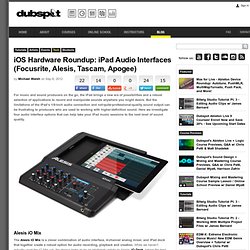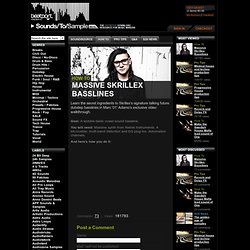

Learn Native Instruments MASCHINE - Classes in NYC & ONLINE. iOS Hardware Roundup: iPad Audio Interfaces (Focusrite, Alesis, Tascam, Apogee) For music and sound producers on the go, the iPad brings a new era of possibilities and a robust selection of applications to record and manipulate sounds anywhere you might desire.

But the limitations of the iPad’s 1/8-inch audio connection and not-quite-professional-quality sound output can be frustrating to producers who are used to working with higher-definition sound. Here we investigate four audio interface options that can help take your iPad music sessions to the next level of sound quality. Alesis iO Mix The Alesis iO Mix is a clever combination of audio interface, 4-channel analog mixer, and iPad dock that together create a robust option for audio recording, playback and creation. Focusrite iTrack Solo Focusrite, a British company known for affordable high-performance audio interfaces for computers, has introduced its first iOS device with the iTrack Solo — a two-channel audio interface created for the iPad.
Tascam iU2 Apogee One. Massive Skrillex Basslines « Music Production Tips. Goal: A wobble-tastic vowel sound bassline.

You will need: Massive synth from Native Instruments. A bit-crusher, multi-band distortion and EQ plug-ins. Automation channels. And here’s how you do it: Comments nice! Right like skrillex is the innovator. [...] Who is Skirillex? [...] the Beatport charts as of late with his larger than life dubstep and drum & bass tracks. I used fm8 for the gargles. oh god, now everyone will be making that awful noise that sucks SO bad seriously people, it’s NOT good music…and drugs make it worse Nice.. That bass is the roar of a dragon.. Cool..why don’t make an “how to do bass like Carlo lio” or something like that this is interesting for real but still make your own styles with his start Haha, nice try. Great work thankyou for the info “) Using Maschine w/ Logic Pro: Standalone Mode – ‘Secret Knowledge’ w/ Matt Shadetek.
DJ/producer, Dubspot instructor and Logic Pro course designer Matt Shadetek returns with a new video tutorial series titled Secret Knowledge.

In part one of this two-part installment of Secret Knowledge, Shadetek explores one of two distinct ways of using Native Instruments’ Maschine with Logic Pro: using Maschine in standalone mode and syncing with Logic. For the first episode of my new Secret Knowledge series of Logic Pro tutorials we’ll focus on using Logic with Native Instruments’ Maschine, first looking at how to use Maschine as a standalone application and then next time using Maschine as a plug-in inside of Logic. In order to use Maschine in standalone mode with Logic we’re going to want to sync the two of them together.
I show how to do this in the video by sending MIDI sync from Logic to Maschine. Because this sync method can be a little loose, this can be useful for getting a basic idea down but we’ll want to get the audio out of Maschine into Logic pretty quickly. Electronic Music Theory: Analyzing Dubstep Basslines - "3 Fist Style" by Datsik. This week we’re going to continue our electronic music theory posts analyzing dubstep basslines by looking at the track “3 Fist Style” by Canadian DJ/producer Datsik.

Datsik Who did that to you? He is a lone wolf, many enemies, his name is Datsik… - sampled kung-fu movie dialogue from the track “3 Fist Style” (Basshead, 2010) by Datsik I have chosen this track because the notes that comprise its bassline come from a single scale or mode, but rather an unusual one, the double harmonic major scale, sometimes also referred to as the “Byzantine” or “Arabic” scale in some sources (although these names are not really historically accurate). What Is A Scale Anyway?
In music theory, a scale is nothing more than a specific set of notes that forms the basis of a musical composition. Probably the most familiar scale in Western music is C Major, made up of all the white keys on the keyboard starting on C: What notes are used here?